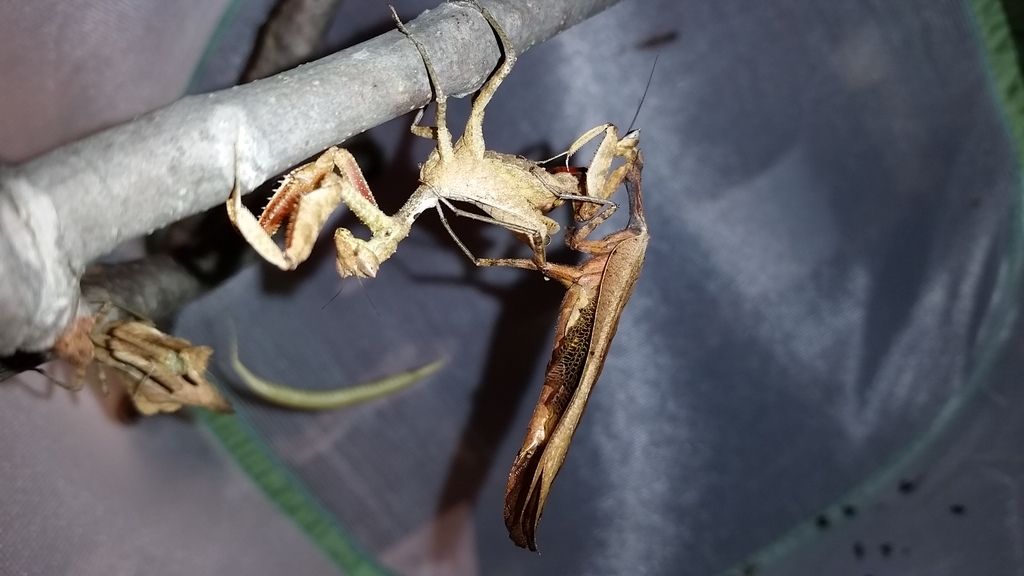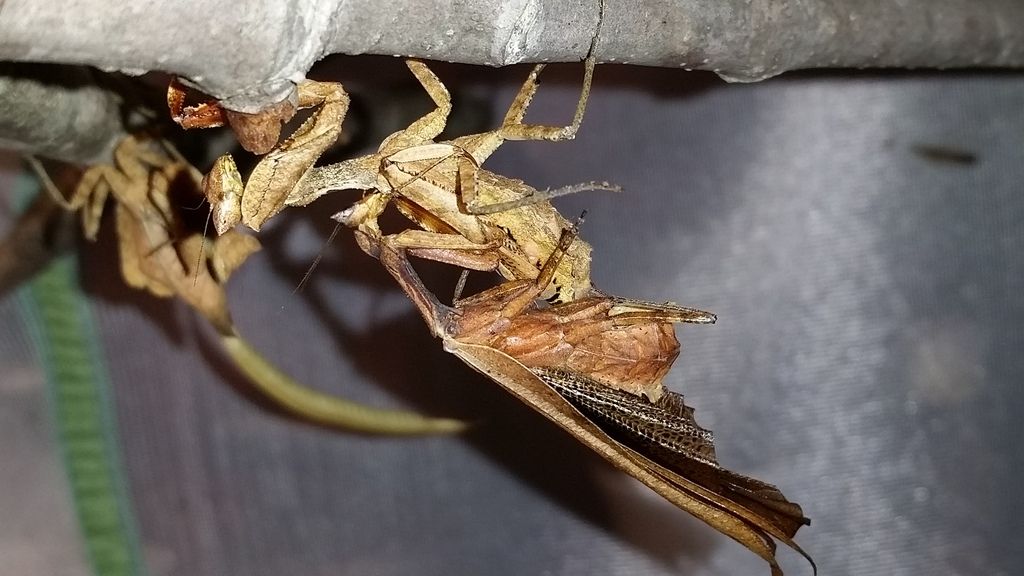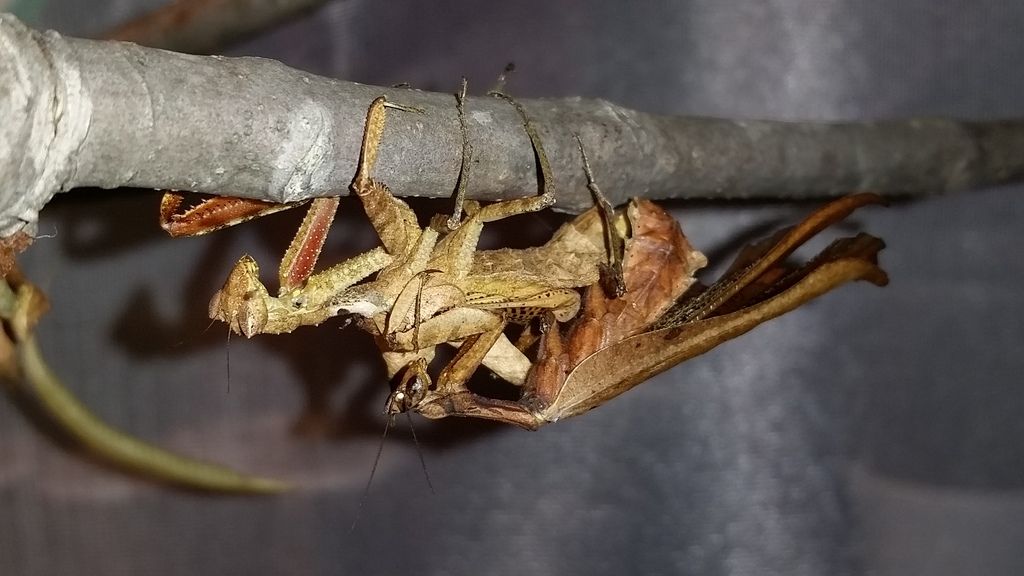MantisMatt14
Well-known member
First of all, hats off to Henry (Precarious) for giving me the opportunity to work with this species.
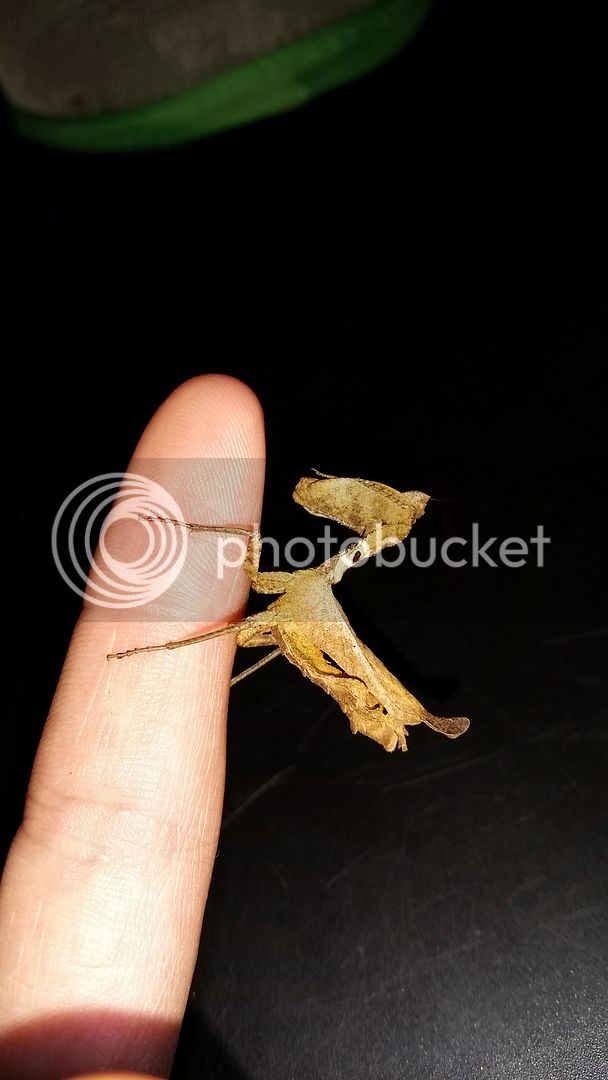
Recently, I aquired one of the most interesting mantids on the planet, South American Dead leafs! These mantids ranging from Central to South America live in cloud forests hidden from all predators yet they stay in plain sight. The family Acanthopidae has many species that all exhibit the trait of being extremely cryptic. The neotropical mantids that I got are Acanthops erosula and Decimiana bolivari. The Acanthops are very cryptic and the abdomens have many fringed crests and bumps mimicking dead leaves. As adults, the males have very large wings that extend over the abdomen and taper to points on each end. This gives them the very dramatic leaf effect. The females of both Acanthops and Decimiana are very bulky and the wings are not meant for flying. They are just to cover up the vivid red spot on the abdomen only shown when threatened. The wings hang high over the back and they have a very crumpled look. This species is hangs upside down using gravity to its advantage and they are almost invisible to any potential predators resembling a dead leaf attached to a branch. One of the only noticeable morphological differences between Acanthops and Decimiana is that the females of D. bolivari have a much different abdomen shape and they appear much smaller than the females of A. erosula. Overall, I am very happy to finally have these species to work with.
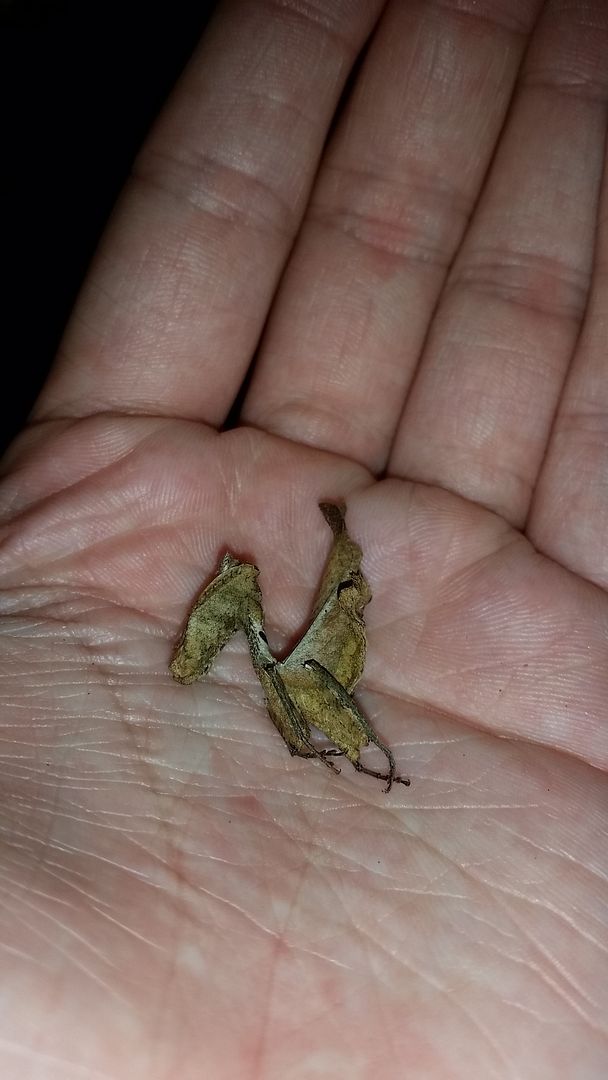
These girls may be small but they will take down prey the same size as themselves! Very strong mantids with large appetites. This species relies strictly on mimicry to not be found by predators. These dead leaves if found will shake violently and sway to mirror a leaf blowing in a slight breeze. If further pestered, this mantis will curl up and drop to the ground to become hidden in the leaf litter. Very lovely species with so much interesting behaviors to stay alive!
8/16/15
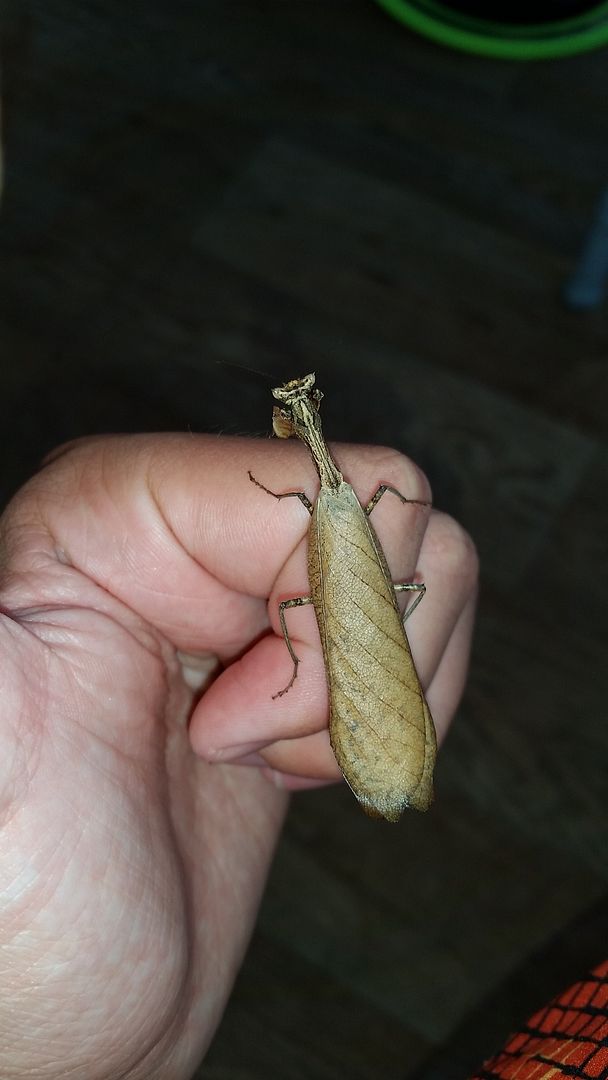
Male Decimiana bolivari molted to adult yesterday! These nymphs have only 5 instars and can molt from egg to adult within 2 1/2 months! The females have an extra instar but with the wings, males are longer than most females of this species. As adults, they can mate within a week after maturing and the females have a bright red spot on the abdomen. Males mimic leaves that have fallen from the canopy in rainforests and females pose as dead leaves clinging to branches. Hurry up girls!
8/18/15
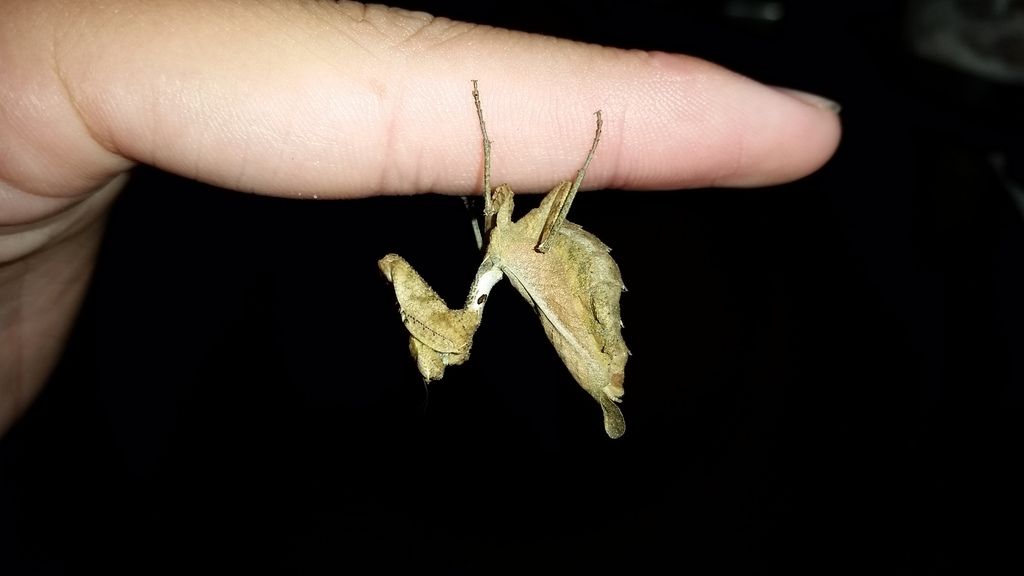
1st female molted to adult today. These mantids are one of the only species with the males are actually larger than the females. The gals of this species are quite robust and stocky whereas the males are very long and thin. Although this female could still easily kill a male, little cannabalism occurs when copulating. The male D. bolivari can be ready to start mating within a week of maturing and once the female starts calling I will pair them up. Wish me luck with the breeding! Such a beautiful mantis with very good mimicry!
8/25/15
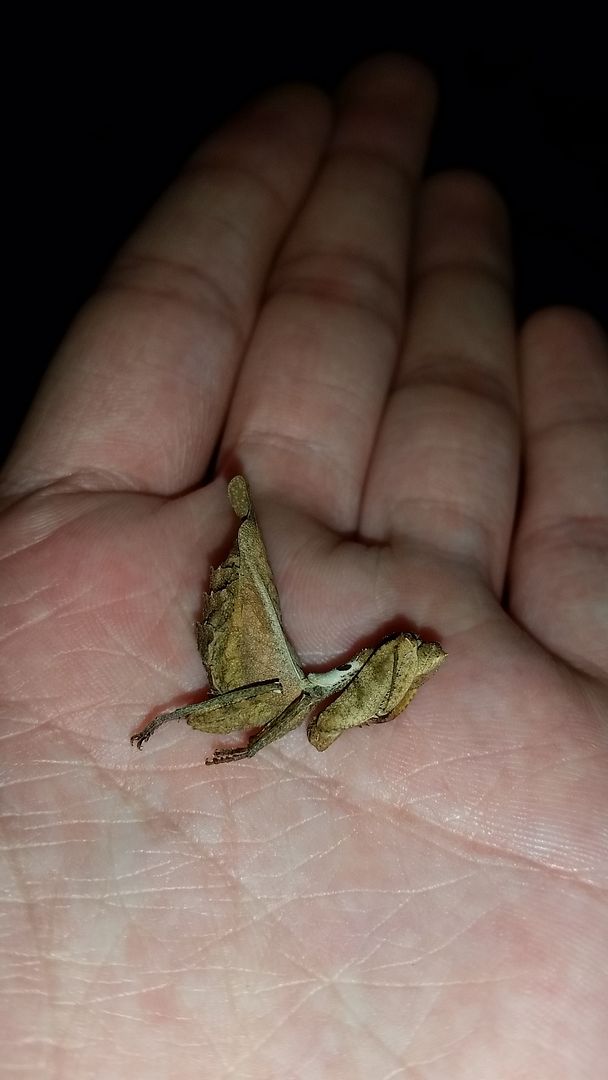
Second female molted to adult tonight. As adults, the play dead strategy when disturbed is most effective for mature female Dead leaf mantids because their wings resemble crumpled dead leaves. Due to nymphs not having wings to add to the act, the feigning death behavior is less convincing. So even though the adults are larger than the nymphs of this species, they still have a better shot at survival since they have cryptic wings!
9/4/15
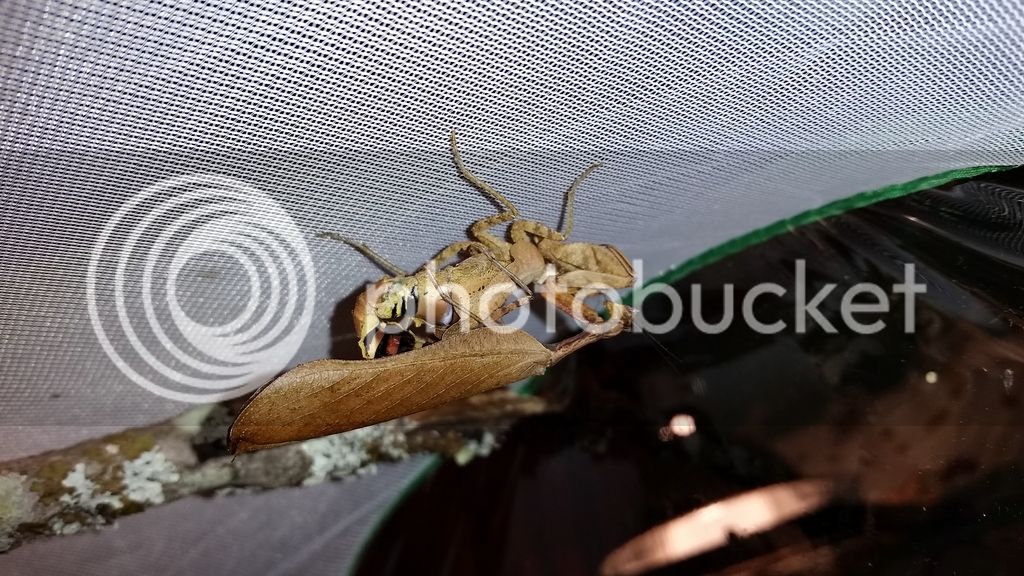
My 18 day old adult female Decimiana bolivari started calling the other day. When a female mantis starts calling, she emits a species specific sex pheromone to attract males to her location. The month old male happily connected with her this morning after feeding her extra last night. It wasn't that easy at first for the male. When they crossed paths, she unexpectedly grabbed him and bit off part of his first leg. Seems like this did not bother him because the male acted perfectly fine after! Glad that wasn't his head or body she injured. This girl could cause him serious damage due to being so much stronger than him. At any given moment during the copulation of this Decimiana bolivari pair, the female could turn around and start devouring the male. Unlike the Orchid mantis, South American Dead leaf males are longer than the females. This makes them much more accessible to the female if she gets hungry. Hopefully she does not decide to kill her mate and he will be able to fertilize my second female when she starts calling! So far success with this lovely species. Can't wait to see the next generation of this mantis!
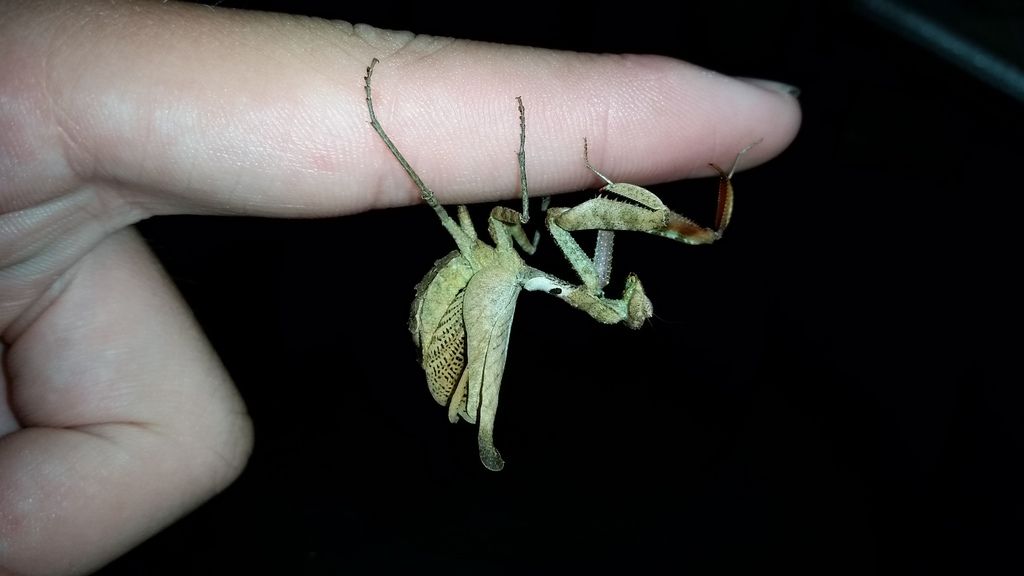
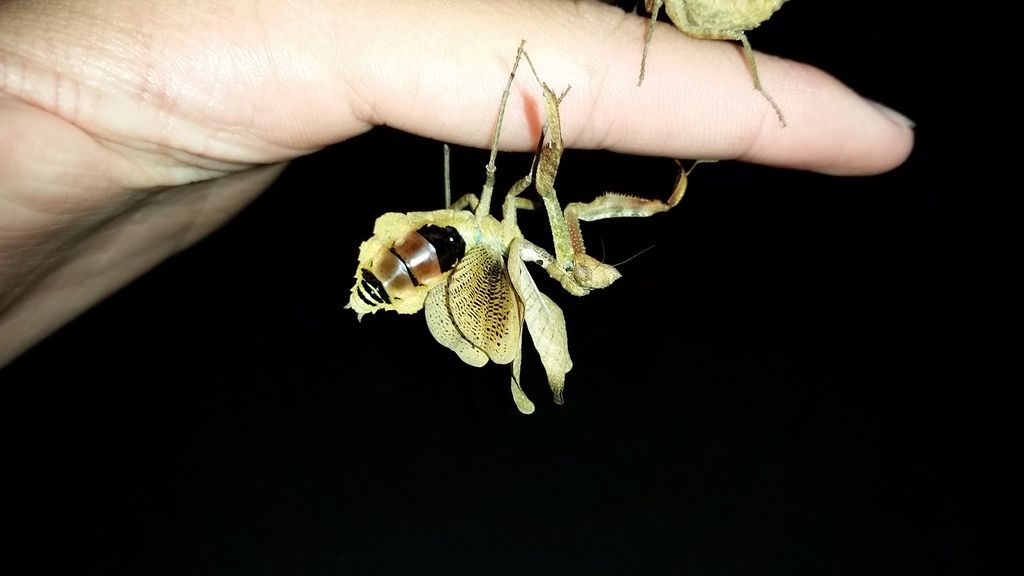
9/5/15
Threat display of a very annoyed female Decimiana bolivari. This girl is the most sassy of the two girls I have. I'm going to be very cautious when I attempt to mate her with my male. She seems to strike every living thing and I really don't want my male to become her next meal! Wish me luck!
9/8/15
The more I observe the species, the more I wish to see them in the wild someday! Female Decimiana bolivari, a perfect dead leaf mimic in the rainforest. A very agile predator with a very big appetite. The females of this mantis species are flightless and only used their patterned wings for displaying when disturbed.
9/9/15
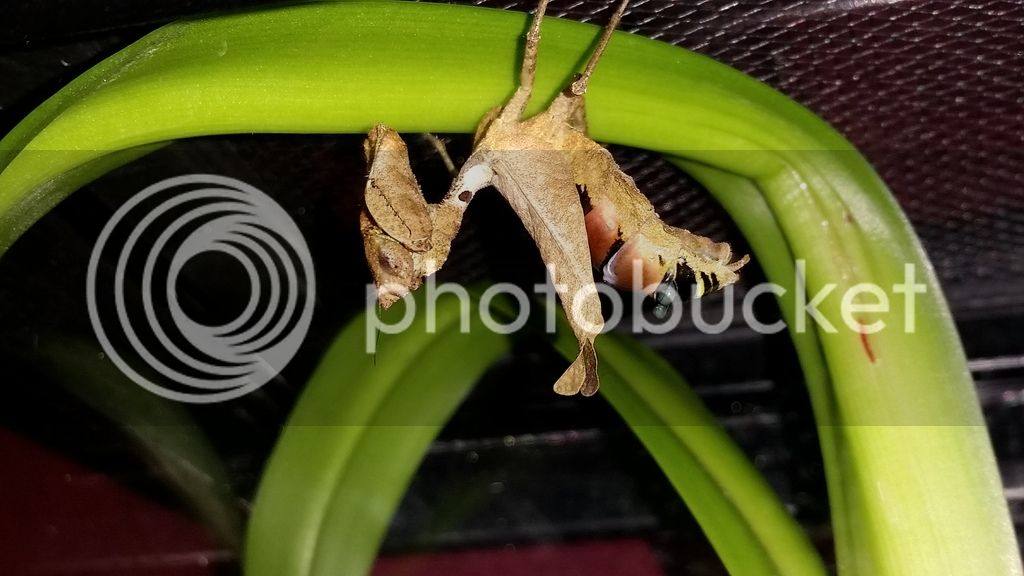
South American dead leafs in the genus Acanthopidae mate peacefully. In the rainforest on a humid night, many insects are active including Acanthops genus mantids. Males of these species hide in the leaf litter by day and take to the trees at night. The females are flightless and have very short wings, this means they will not go looking for males to fertilize them. The female D. bolivari emits a species specific sex pheromone into the night to attract males. This is an open invitation of coming to mate with her. Sending out that pheromone tells the males that she will not make a meal of her suiter let alone take some chunks out of his head during copulation. Depicted here is one of my very pretty female Decimiana bolivari calling. During this posture, she sprays perfume in the air for the males letting them know she is ready to mate. At this very moment, my other female who is older, is laying her first Oothecae! I'll try to get a timelapse of this fairy-like species laying her ooth!
9/12/15
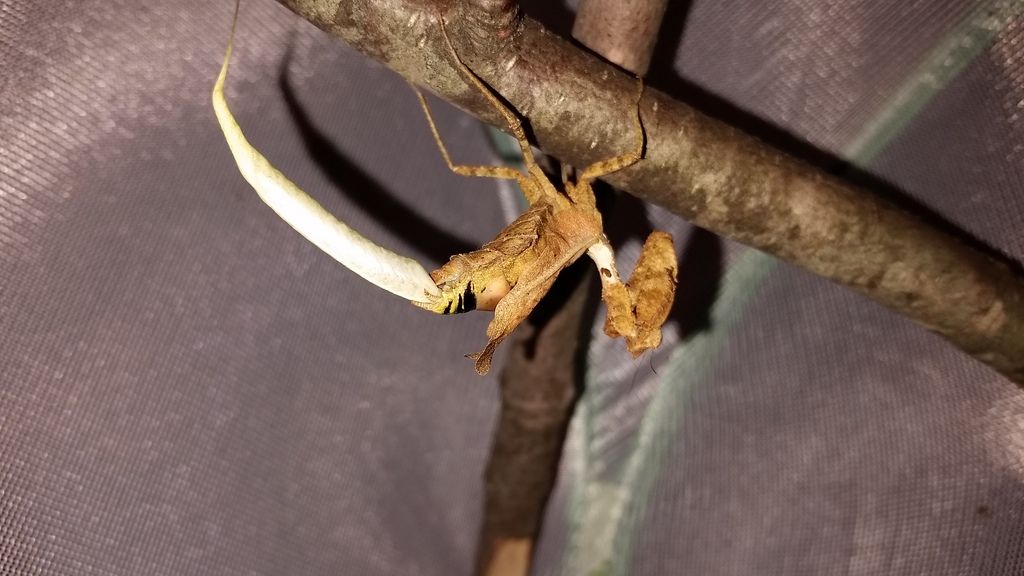
1st mated female laid her ooth last night. It was so amazing to watch her construct this structure. Never heard of mantids laying them suspended in the air until now. They must mimic seed pods or other plants and the nymphs stay on it after hatching. Fertile oothecae number one! More to come!

Recently, I aquired one of the most interesting mantids on the planet, South American Dead leafs! These mantids ranging from Central to South America live in cloud forests hidden from all predators yet they stay in plain sight. The family Acanthopidae has many species that all exhibit the trait of being extremely cryptic. The neotropical mantids that I got are Acanthops erosula and Decimiana bolivari. The Acanthops are very cryptic and the abdomens have many fringed crests and bumps mimicking dead leaves. As adults, the males have very large wings that extend over the abdomen and taper to points on each end. This gives them the very dramatic leaf effect. The females of both Acanthops and Decimiana are very bulky and the wings are not meant for flying. They are just to cover up the vivid red spot on the abdomen only shown when threatened. The wings hang high over the back and they have a very crumpled look. This species is hangs upside down using gravity to its advantage and they are almost invisible to any potential predators resembling a dead leaf attached to a branch. One of the only noticeable morphological differences between Acanthops and Decimiana is that the females of D. bolivari have a much different abdomen shape and they appear much smaller than the females of A. erosula. Overall, I am very happy to finally have these species to work with.

These girls may be small but they will take down prey the same size as themselves! Very strong mantids with large appetites. This species relies strictly on mimicry to not be found by predators. These dead leaves if found will shake violently and sway to mirror a leaf blowing in a slight breeze. If further pestered, this mantis will curl up and drop to the ground to become hidden in the leaf litter. Very lovely species with so much interesting behaviors to stay alive!
8/16/15

Male Decimiana bolivari molted to adult yesterday! These nymphs have only 5 instars and can molt from egg to adult within 2 1/2 months! The females have an extra instar but with the wings, males are longer than most females of this species. As adults, they can mate within a week after maturing and the females have a bright red spot on the abdomen. Males mimic leaves that have fallen from the canopy in rainforests and females pose as dead leaves clinging to branches. Hurry up girls!
8/18/15

1st female molted to adult today. These mantids are one of the only species with the males are actually larger than the females. The gals of this species are quite robust and stocky whereas the males are very long and thin. Although this female could still easily kill a male, little cannabalism occurs when copulating. The male D. bolivari can be ready to start mating within a week of maturing and once the female starts calling I will pair them up. Wish me luck with the breeding! Such a beautiful mantis with very good mimicry!
8/25/15

Second female molted to adult tonight. As adults, the play dead strategy when disturbed is most effective for mature female Dead leaf mantids because their wings resemble crumpled dead leaves. Due to nymphs not having wings to add to the act, the feigning death behavior is less convincing. So even though the adults are larger than the nymphs of this species, they still have a better shot at survival since they have cryptic wings!
9/4/15

My 18 day old adult female Decimiana bolivari started calling the other day. When a female mantis starts calling, she emits a species specific sex pheromone to attract males to her location. The month old male happily connected with her this morning after feeding her extra last night. It wasn't that easy at first for the male. When they crossed paths, she unexpectedly grabbed him and bit off part of his first leg. Seems like this did not bother him because the male acted perfectly fine after! Glad that wasn't his head or body she injured. This girl could cause him serious damage due to being so much stronger than him. At any given moment during the copulation of this Decimiana bolivari pair, the female could turn around and start devouring the male. Unlike the Orchid mantis, South American Dead leaf males are longer than the females. This makes them much more accessible to the female if she gets hungry. Hopefully she does not decide to kill her mate and he will be able to fertilize my second female when she starts calling! So far success with this lovely species. Can't wait to see the next generation of this mantis!


9/5/15
Threat display of a very annoyed female Decimiana bolivari. This girl is the most sassy of the two girls I have. I'm going to be very cautious when I attempt to mate her with my male. She seems to strike every living thing and I really don't want my male to become her next meal! Wish me luck!
9/8/15
The more I observe the species, the more I wish to see them in the wild someday! Female Decimiana bolivari, a perfect dead leaf mimic in the rainforest. A very agile predator with a very big appetite. The females of this mantis species are flightless and only used their patterned wings for displaying when disturbed.
9/9/15

South American dead leafs in the genus Acanthopidae mate peacefully. In the rainforest on a humid night, many insects are active including Acanthops genus mantids. Males of these species hide in the leaf litter by day and take to the trees at night. The females are flightless and have very short wings, this means they will not go looking for males to fertilize them. The female D. bolivari emits a species specific sex pheromone into the night to attract males. This is an open invitation of coming to mate with her. Sending out that pheromone tells the males that she will not make a meal of her suiter let alone take some chunks out of his head during copulation. Depicted here is one of my very pretty female Decimiana bolivari calling. During this posture, she sprays perfume in the air for the males letting them know she is ready to mate. At this very moment, my other female who is older, is laying her first Oothecae! I'll try to get a timelapse of this fairy-like species laying her ooth!
9/12/15

1st mated female laid her ooth last night. It was so amazing to watch her construct this structure. Never heard of mantids laying them suspended in the air until now. They must mimic seed pods or other plants and the nymphs stay on it after hatching. Fertile oothecae number one! More to come!
Last edited by a moderator:




